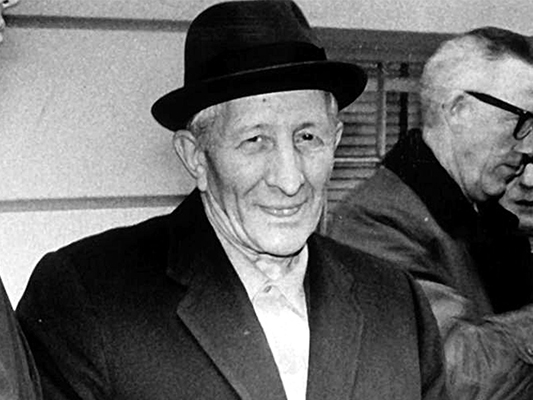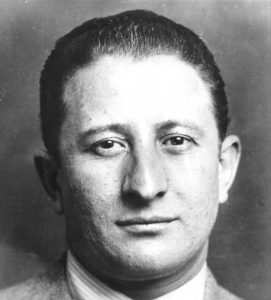Carlo Gambino

Born: August 24, 1902, Palermo, Sicily
Died: October 15, 1976, Long Island, New York
Nicknames: Don Carlo, The Godfather
Associates: Charles “Lucky” Luciano, Tommy Lucchese, Paul Castellano, John Gotti
Small in stature with a prominent nose and sporting an almost-permanent friendly grin used to disarm detractors, Carlo Gambino was the American Mafia’s most powerful and respected don from the late 1950s until he died peacefully of natural causes in 1976 as the face of organized crime in New York City.
Known for his quiet, understated demeanor and razor-sharp criminal savvy, Gambino was a teenage hitman in Sicily, alleged to be “made” into the Mafia overseas before coming to the United States in 1921 at age 19 and going to work for cousins connected to gangland factions in New York. His cousins were employed by East Coast Prohibition-era Mob boss Salvatore “Toto” D’Aquila, for whom he too immediately went to work.
When D’Aquila was killed by rival gangster Giuseppe “Joe the Boss” Masseria in 1928, Gambino shifted his allegiance to the Masseria gang, which fought a four-year war for underworld supremacy in New York against Salvatore Maranzano, a crime lord hailing from a different section of Sicily than Masseria and Gambino did. At the end of the war, Masseria and Maranzano were gone, shot dead in ambushes, and the modern-day American Mafia was formed.
Gambino went on to become an original member of one of the five New York crime families designated under the La Cosa Nostra banner, the one belonging to Vincent Mangano and the one that eventually would be named for him. In the 1930s, Gambino was convicted of running an illegal liquor still and served almost two years in federal prison, the last time he would ever serve time behind bars.
Mangano and his brother, Philip, were slain on the same day in 1951 on the orders of Mangano’s underboss, Albert Anastasia, and six years later, in the fall of 1957, Gambino himself orchestrated Anastasia’s murder and assumed command of the crime family for the next 19 years. Under his guidance, the Gambino syndicate expanded into territories and rackets it hadn’t in the past, taking almost complete control of labor unions on the New York and New Jersey waterfront, at JFK Airport and in the trucking, construction and garment industries along the entire East Coast. They profited handsomely from an array of white-collar scams and finance-district fleeces.
The unofficial chairman of the board of the Mafia’s Commission – the ruling council made up of the country’s most important dons – Gambino was beloved by his men and many of his fellow godfathers in New York and across the nation. He forged strong ties with Mob bosses in New England, New Jersey, New Orleans, Florida, Chicago, California, Pennsylvania and Detroit, among other locales, broadening his reach well beyond his Empire State stomping grounds.

Gambino discouraged narcotics trafficking among his troops, instituting a “deal and die” policy. He was leery of the long sentences they could incur for drug offenses, which could provide reason for them to cooperate with authorities. He preferred instead to stick to traditional Mob rackets such as bookmaking, loansharking, hijacking and extortion, as well as maintaining as much a presence as possible in the labor unions.
He married his son off to the daughter of fellow New York Mafia boss Tommy “Three-Finger Brown” Lucchese, and he was cousin and brother-in-law to Paul Castellano, one of his highest-earning crew bosses.
Hounded by the FBI for decades, such as in 1970 when he was indicted for masterminding a major East Coast burglary ring, the government never nailed him. He was known for offering arresting FBI agents coffee and dessert at his home before they took him in for booking.
Two years later, in 1972, Gambino’s 30-year-old nephew Manny was kidnapped and murdered by an Irish Mob crew led by James “Jimmy from Queens” McBratney. The Irish hoodlums had been kidnapping Italian Mafiosi and extorting six-figure cash ransoms for their release for more than a year when they grabbed the younger Gambino. Demanding swift vengeance, Gambino called on John Gotti, then an up-and-comer in the ranks of his crime family and the protégé of his underboss Neil Dellacroce. Gotti, his best friend Angelo “Fat Angie” Ruggiero and another wiseguy named Ralph “Ralphie Wigs” Galione gunned down McBratney in a Staten Island tavern in May 1973. They all eventually were convicted and imprisoned for the crime.
Carlo Gambino battled health problems in his later years, finally succumbing to heart disease on October 15, 1976, at his Long Island waterfront home. Before dying, Gambino controversially bypassed his No. 2 in charge, Dellacroce, in favor of his brother-in-law Castellano, a more corporate-style goodfella, leaving his syndicate on shaky ground in subsequent years. Dellacroce’s death from lung cancer in early December 1985 and Castellano’s decision to skip his underboss’s wake brought about a Gambino clan coup, in which Dellacroce’s pupil, Gotti, staged the murder of Castellano and his right-hand man, Tommy Bilotti, on a crowded Manhattan street in front of the popular Sparks Steak House and grabbed control of the crime family by force.
The title character in the most critically acclaimed Mob movie of all time, The Godfather, was inspired in part by Carlo Gambino.
More than 40 years after Gambino’s death, the New York crime family is still named for him. Although decimated by the federal crackdown during the Gotti era, the Gambino family is still involved in various criminal activities in Brooklyn and Staten Island.




